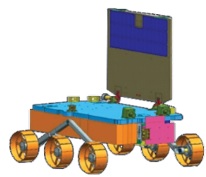Chandrayaan 2 Details and Rover Name list in India PDF Download | India’s Moon Mission Chandrayaan 2
Chandrayaan-2 is India’s second lunar exploration mission after Chandrayaan-1. Chandrayaan-1 was launched on Oct, 2008.
| Facts | Information |
| Developed | By ISRO (Indian Space Research Organisation) |
| Objective | to demonstrate the ability to soft-land on the lunar surface and operate a robotic rover on the surface. Scientific goals include studies of lunar topography, mineralogy, elemental abundance, the lunar exosphere, and signatures of hydroxyl and water ice. The orbiter will map the lunar surface and help to prepare 3D maps of it. The onboard radar will also map the surface while studying the water ice in the south polar region and thickness of the lunar regolith on the surface. |
| Launched Date | 22nd July 2019 |
| Launch Site | Satish Dhawan Space Centre, Second Launch Pad |
| Mission Type | Luner orbiter, lander, rover |
| Mission Duration & Power | Orbiter : 1 year, 1 KW
Vikram Lander : < 15 days, 650 W Pragyan rover : < 15 days, 50 W |
| Rocket | GSLV Mk III |
| Orbital Insertion | 20th Aug 2019 |
| cryogenic engine of Rocket | filled with Helium |
Landing of Payload
The lander and the rover will land near the lunar south pole region in a high plain between two craters, Manzinus C and Simpelius N, at a latitude of about 70° south on 7 September 2019. The wheeled Pragyan rover will move on the lunar surface and will perform on-site chemical analysis for a period of 14 days (one lunar day). It can relay data to Earth through the Chandrayaan-2 orbiter and lander, which were launched together on the same rocket. The orbiter will perform its mission for one year in a circularized lunar polar orbit of 100 × 100 km.
India Place on Moon mission
A successful landing would make India the fourth country to achieve a soft landing on the Moon, after the space agencies of the USSR, US and China. If successful, Chandrayaan-2 will be the southernmost lunar landing.
Chandrayaan-2 History & Reason of Delay
Agreement : On 12 November 2007, representatives of the Russian Federal Space Agency (Roscosmos) and ISRO signed an agreement for the two agencies to work together on the Chandrayaan-2 project. ISRO would have the prime responsibility for the orbiter and rover, while Roscosmos was to provide the lander. The Indian government approved the mission in a meeting of the Union Cabinet, held on 18 September 2008 and chaired by Prime Minister Manmohan Singh.
Mission Design : The design of the spacecraft was completed in August 2009, with scientists of both countries conducting a joint review.
Independence due to Lander : Although ISRO finalised the payload for Chandrayaan-2 per schedule, the mission was postponed in January 2013 and rescheduled to 2016 because Russia was unable to develop the lander on time. When Russia cited its inability to provide the lander even by 2015, India decided to develop the lunar mission independently.
Testing and Configuration : The spacecraft’s launch had been scheduled for March 2018, but was first delayed to April and then to October to conduct further tests on the vehicle. On 19 June 2018, after the program’s fourth Comprehensive Technical Review meeting, a number of changes in configuration and landing sequence were planned for implementation, pushing the launch to the first half of 2019.Two of the lander’s legs got minor damage during one of the tests in February 2019.
Chandrayaan-2 launch was initially scheduled for 14 July 2019. However, the launch was aborted due to a technical glitch and rescheduled to 22 July 2019.
Mission Cost : ₹978 crore (approximately US$141 million)
Orbiter
The orbiter will orbit the Moon at an altitude of 100 km (62 mi). The orbiter carries five scientific instruments. Three of them are new, while two others are improved versions of those flown on Chandrayaan-1. The approximate launch mass was 2,379 kg.
Vikram Lander
The mission’s lander is called Vikram named after Vikram Sarabhai(1919–1971), who is widely regarded as the father of the Indian space programme.
The payloads on the Vikram lander are:
- ILSA Seismometer for studying Moon-quakes near the landing site.
- ChaSTE Thermal probe for estimating the thermal properties of the lunar surface.
- RAMBHA-LP Langmuir probe for measuring the density and variation of lunar surface plasma.
- LRA for taking precise measurements of distance between the reflector on the lunar surface and satellites in lunar orbit.
Pragayan Rover
The mission’s rover is called Pragyan. The rover’s mass is about 27 kg (60 lb) and will operate on solar power.The rover will move on 6 wheels traversing 500 meters on the lunar surface at the rate of 1 cm per second, performing on-site chemical analysis and sending the data to the lander, which will relay it to the Earth station.

Payload
ISRO selected eight scientific instruments for the orbiter, four for the lander,and two for the rover.
India Moon Mission Chandrayaan-2 PDF
All the best for your upcoming exam!
You can join or visit at Facebook Page or Twitter for always keep in touch with further updates.
